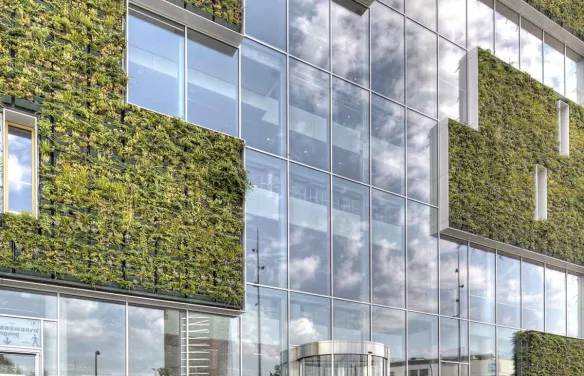Every time I attend a fire test I’m impressed and proud of the fire safety performance of our Pyrobel fire-resistant glass.
Short biography
Camélia Matean joined AGC in 2002 as a development engineer in the Fire Resistant Glass (FRG) Business Unit. In 2009, she took over as head of the Pyrobel Development & Applications department, in charge of product development and certifications. Since 2019, she has served as Product Manager for AGC Pyrobel Fire-Resistant Glass. She and her team work on new fire tests and certifications to ensure fire safety for everyone. Camélia holds a master’s degree in civil engineering, specialising in polymer chemistry.

In June 2017, Fire Safe Europe compared building regulations and fire safety requirements across Europe. The analysis revealed astonishing discrepancies between member states. The tragic Grenfell Tower fire in London in June 2017 was a turning point in fire safety.
Over the past five years multiple EU member states have taken action to revise their regulations with a view to improving fire safety in buildings.
Fire resistance is defined as the period of time (in minutes) during which the glass element meets one or more criteria (E, EW, EI). For example, EI30 means that in the event of a fire the glass element will maintain integrity and insulation (EI) for at least 30 minutes.

AGC has been manufacturing fire-resistant glass for more than 40 years. Over the years the range has expanded and evolved so that it is now very complete, meeting all of the market’s safety and security requirements as well as architects’ wishes.
We are the only glass manufacturer with two different laminated fire-resistant glass technologies, Pyrobel and Pyrobel-T (toughened), meaning we can ensure usability in all types of applications and compliance with fire protection classes.
A new trend in safety involves combining fire protection with anti-burglary or anti-bullet functionality. We have developed glass products that meet these requirements.
We use standardised testing methods to assess the conformity of fire-resistant glass. The glass is one component in the element that must resist fire. The glass is fitted in a specific frame, which must then be fire-tested as a whole.
Fire resistance tests are carried out in accredited laboratories where the glass elements are placed in large ovens that simulate a real fire. Temperatures in the oven can reach up to 1000 °C.
- Integrity is assessed using gauges for protection class E.
- The radiation measured at one meter from the unexposed surface must remain below 15 kW/m2 for class EW.
- The average temperature measured using thermocouples on the unexposed glass surface must remain below 140 °C for protection class EI.
We also have three in-house test ovens at AGC capable of handling dimensions up to 3 x 4 m. We use these ovens to regularly verify current production performance, develop new products and prepare for official tests. We also use our multiple furnaces to help frame manufacturers develop their products and validate their fire-resistant systems with glass elements (glass partitions, windows, doors) by performing fire pre-tests in accordance with the test methods set out in EN 1363-1.
Since our focus is on safety, our internal safety tests and requirements are stricter than the official international requirements. We recently performed a fire test under the supervision of French certification body Efectis France on a 29-year-old Pyrobel unit dismantled from a building. Its fire performance was perfect – by a significant margin.
We carry out more than 100 official and in-house fire tests per year.
Our entire product range is tested in accordance with standard EN12600 for injury and fall protection. This mechanical performance standard specifies a pendulum impact test and relates to increasing personal safety by:
✔ the reduction of cutting and piercing injuries to persons
✔ the containment characteristics of the material
The Pyrobel anti-bullet range has been tested in accordance with standard EN 1063. The glass sample (measuring 50 x 50 cm) is held firmly in a frame. Three projectiles are then fired at the glass from a distance of between 5 and 10 metres and at a very precise angle to the glass. The impacts form an isosceles triangle, where each side is 12 cm long. The test is considered successful if no bullet passes through the window. Depending on the type of weapon and ammunition used, the classification ranges from the lowest class BR1 (handgun) to the highest class BR6 (assault rifle).
Spontaneous breakages of toughened glass are often caused by nickel sulphide (NiS) inclusions. All of our Pyrobel-T (our toughened laminated glass) panes are subjected to a Heat Soak Test (HST) to eliminate those panes likely to fracture.
Protecting the environment is our priority. At AGC we are always looking for ways to reduce our ecological footprint. Germany’s ift Rosenheim institute has checked and approved the EPDs for Pyrobel.
Our products focus on sustainability and health. They contain no toxic components and no toxic gasses are released in case of fire. We comply with:
- the REACH Regulation
- the RoHS Directive
- Material Health Certification Silver level
Pyrobel is the only fire-resistant glass on the market that is Cradle to Cradle CertifiedTM Silver. We achieved gold in the material reutilisation, renewable energy, water stewardship and social fairness categories, and silver in the raw materials category.


